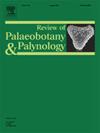4.1亿年前Rhynie chert真菌间关系的解读:球囊菌(形成孢子的球囊菌科)和相关的微真菌
IF 1.7
3区 地球科学
Q2 PALEONTOLOGY
引用次数: 0
摘要
来自苏格兰下泥盆世Rhynie岩的肾小球菌科(丛枝菌根真菌)的化石记录包括各种各样的孢子,其中大多数是在陆地植物的轴中单独形成的;只有少数被报道为孢子囊。Rhynie燧石也提供了充分的证据,证明这些孢子作为其他真菌的栖息地和营养基础是有吸引力的。在这里,我描述了一种来自Rhynie chert的新的肾小球孢子皮,Glomites bacatus nov. sp.,它由100多个球状孢子组成,并被紧密交错和互锁的菌丝所包裹,具有囊泡样的膨胀。手头标本的周膜和孢子都被其他真菌定植,包括类似于双角根菌的壶状菌体。与孢子囊相关的其他遗迹可能属于真菌样卵菌。其中包括与衣原体孢子相似的柄状球体,类似孢子囊的瓶状结构,以及一个假定的含两个大小不等的卵孢子的间胚囊,由一个下胚囊支撑,其中一个卵孢子中有一个受精管。这一发现扩大了我们对Rhynie生态系统中孢子生小球菌的认识,并为这些真菌作为其他微生物生命宿主的功能提供了进一步的证据。本文章由计算机程序翻译,如有差异,请以英文原文为准。
Deciphering interfungal relationships in the 410-million-yr-old Rhynie chert: Glomites bacatus nov. sp. (sporocarp-forming Glomeromycota) and associated microfungi
The fossil record of the Glomeromycota (arbuscular mycorrhizal fungi) from the Lower Devonian Rhynie chert of Scotland includes a wide variety of spores, most of which formed singly in the axes of land plants; only a few have been reported to occur as sporocarps. The Rhynie chert also provides ample evidence that these spores were attractive as a habitat and nutritional basis for other fungi. Here, I describe a new glomeromycotan sporocarp from the Rhynie chert, Glomites bacatus nov. sp., which consists of more than 100 glomoid spores and is completely enveloped by a peridium of tightly interlacing and interlocking hyphae with vesicle-like swellings. Both the peridium and the spores of the specimens at hand are colonized by other fungi, including chytrid-like thalli comparable to Rhizophydites bicornis. Other remains associated with the sporocarps could belong to fungus-like Oomycetes. These include stalked spherules reminiscent of chlamydospores, flask-shaped structures resembling sporangia, and a putative intercalary oogonium containing two unequal-sized oospores and subtended by a hypogynous antheridium with a fertilization tube protruding into one of the oospores. This discovery expands our knowledge of sporocarpic Glomeromycota in the Rhynie ecosystem and provides further evidence for the function of these fungi as hosts for other microbial life.
求助全文
通过发布文献求助,成功后即可免费获取论文全文。
去求助
来源期刊
CiteScore
3.50
自引率
21.10%
发文量
149
审稿时长
6 months
期刊介绍:
The Review of Palaeobotany and Palynology is an international journal for articles in all fields of palaeobotany and palynology dealing with all groups, ranging from marine palynomorphs to higher land plants. Original contributions and comprehensive review papers should appeal to an international audience. Typical topics include but are not restricted to systematics, evolution, palaeobiology, palaeoecology, biostratigraphy, biochronology, palaeoclimatology, paleogeography, taphonomy, palaeoenvironmental reconstructions, vegetation history, and practical applications of palaeobotany and palynology, e.g. in coal and petroleum geology and archaeology. The journal especially encourages the publication of articles in which palaeobotany and palynology are applied for solving fundamental geological and biological problems as well as innovative and interdisciplinary approaches.

 求助内容:
求助内容: 应助结果提醒方式:
应助结果提醒方式:


